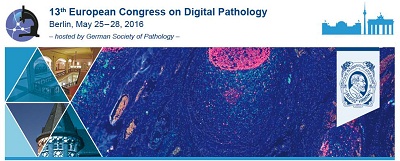Bridge The Distance Between Breast Pathologists: When The Senopath Network Opens Up To The Telepathology
Abstract
Introduction/ Background
In clinical practice, pathologists commonly face breast lesions, which are difficult to diagnose and which re- quire discussion. In Midi-Pyrénées, the largest region ofFrance, this problem has led us to develop in 2011 a peer group for breast diseases entitled SENOPATH.
Aims
In order to reduce second opinion delay, erase geographical barrier and provide continuing education, we aimed to introduce an effective online and outline telepathology system in the SENOPATH network.
Methods
A case review by SENOPATH can be requested by any pathologist in the Midi-Pyrénées region, by filling a form through the ONCOMIP network (organization dedicated to oncology in the Midi- Pyrénées region). The slides are sent for digitalization at The University Cancer Institute - Oncopole, using a Hamamatsu 2.0-RS scanner (until 2014) and a 3DHISTECH Pannoramic 250 scanner, then anonymized and transferred to a shared storage space at Toulouse Paul Sabatier University. Virtual slides can be seen before and/or after the meeting by members of the group by login in the online 3DHISTECHCaseCentervia the Imag’IN platform website. The group, who meets on a monthly basis, has recently developed a synchronized webinar  (using 3DHISTECH Case Center and Pannoramic Viewer) coupled with a conference call in order to ease the attendance of pathologists from remote pathology laboratories. A consensual diagnosis and final pathology report are issued for each case and sent to the referent clinician via the patient medical file securely hosted by ONCOMIP.
Results
From January 2012 to December 2015, 211 cases (39 in 2012, 50 in 2013, 75 in 2014 and 47 in 2015) have been reviewed during 43 meetings. Ten out of 43 meetings (23%) used telepathology. Sixty-one cases out of 211 (29%) were actually digitalized, mainly using theHamamatsu2.0-RS scanner. In average, the number of attending pathologists was9 to 10from 2012 to 2015. The average number of cases reviewed per meeting was 3 in 2012 and 5 between 2013 and 2015. Two main motives for review were identified: diagnostic ‘routine difficulty’ (equivocal or discordant cases, invasive vs in situ lesion, atypical vs malignant lesions, immunohistochemistry scoring pitfalls) or rare tumours. The rare tumour category included among others syringomatous tumour of the nipple, low-grade adenosquamous, myoepithelial, mucoepidermoid or secretory carcinomas, adenomyoepithelioma, atypical microglandular adenosis, sclerosing papillary hyperplasia without myoepithelium and periductal stromal tumour. Molecular analyses requested by the group and implemented in the diagnosis process mainly included immunohistochemistry and fluorescence in situ hybridization (HER2, ETV6, MAML2, MYB).
The SENOPATH network committee review for difficult or rare lesions of the breast has considerably improved the pathologist’s network in our region. This working group is regularly requested by oncologists to solve difficult cases. Our aims for the next few years are 1/ to digitalize all of the cases reviewed by the SENOPATH network, 2/ to use telepathology facilities provided by the Imag’IN platform in order to widen the group to a national level, and 3/ to construct a growing online library of virtual slides for breast challenging lesions.
Â
Downloads

This work is licensed under a Creative Commons Attribution-ShareAlike 4.0 International License.
Authors who publish with this journal agree to the following terms:
1. Authors retain copyright and grant the journal right of first publication with the work simultaneously licensed under a Creative Commons Attribution License that allows others to share the work with an acknowledgement of the work's authorship and initial publication in this journal.
2. Authors are able to enter into separate, additional contractual arrangements for the non-exclusive distribution of the journal's published version of the work (e.g., post it to an institutional repository or publish it in a book), with an acknowledgement of its initial publication in this journal.
3. Authors are permitted and encouraged to post their work online (e.g., in institutional repositories or on their website) prior to and during the submission process, as it can lead to productive exchanges, as well as earlier and greater citation of published work (See The Effect of Open Access).
4. In case of virtual slide publication the authors agree to copy the article in a structural modified version to the journal's VS archive.








